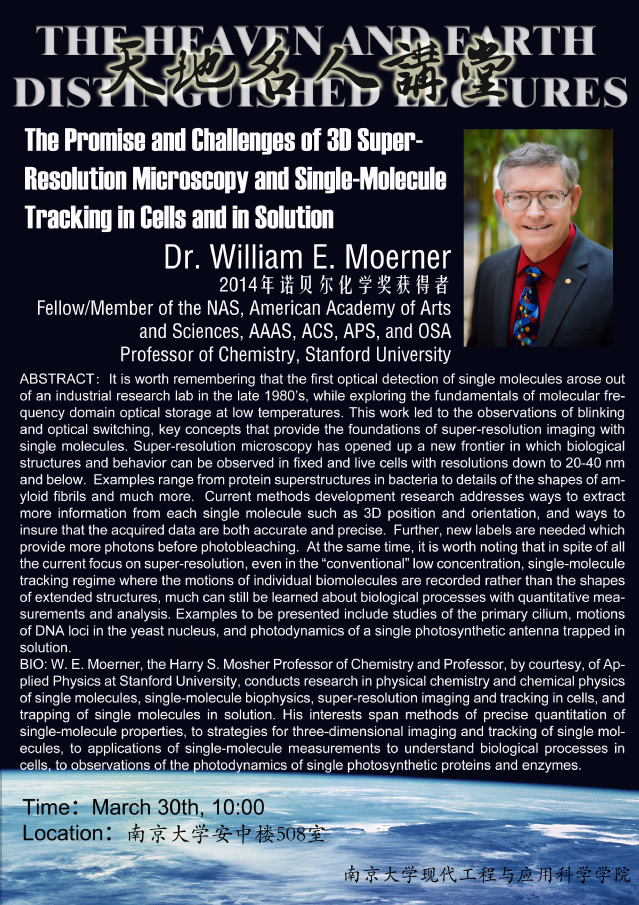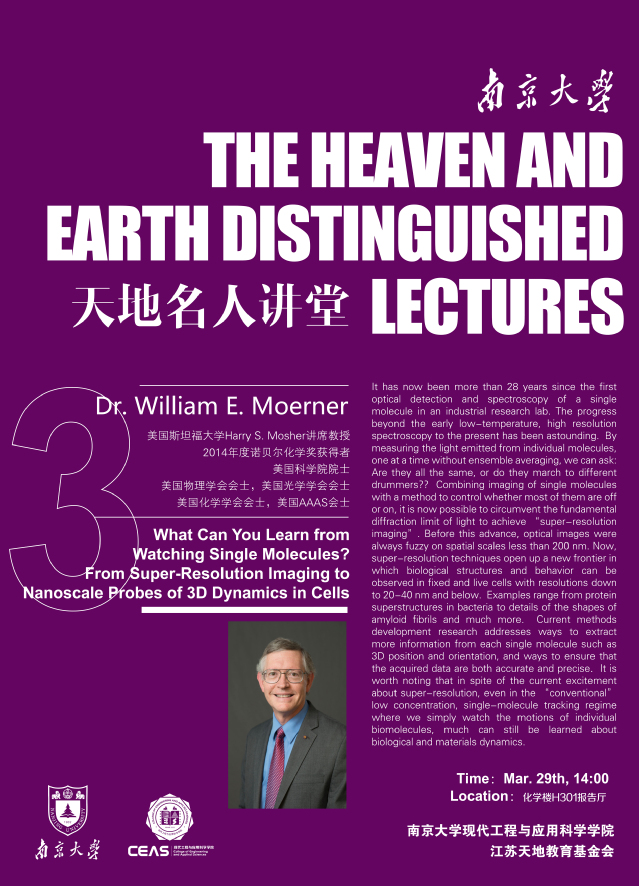我们有幸邀请到2014年诺贝尔化学奖得主美国斯坦福大学化学系教授William Esco Moerner来访并学学术报告。
报告题目: The Promise and Challenges of 3D Super-Resolution Microscopy and Single-Molecule Tracking in Cells and in Solution
时间:3月30日上午10:00
地点:鼓楼校区安中楼508室

报告摘要:
It is worth remembering that the first optical detection of single molecules arose out of an industrial research lab in the late 1980’s, while exploring the fundamentals of molecular frequency domain optical storage at low temperatures. This work led to the observations of blinking and optical switching, key concepts that provide the foundations of super-resolution imaging with single molecules. Super-resolution microscopy has opened up a new frontier in which biological structures and behavior can be observed in fixed and live cells with resolutions down to 20-40 nm and below. Examples range from protein superstructures in bacteria to details of the shapes of amyloid fibrils and much more. Current methods development research addresses ways to extract more information from each single molecule such as 3D position and orientation, and ways to insure that the acquired data are both accurate and precise. Further, new labels are needed which provide more photons before photobleaching. At the same time, it is worth noting that in spite of all the current focus on super-resolution, even in the “conventional” low concentration, single-molecule tracking regime where the motions of individual biomolecules are recorded rather than the shapes of extended structures, much can still be learned about biological processes with quantitative measurements and analysis. Examples to be presented include studies of the primary cilium, motions of DNA loci in the yeast nucleus, and photodynamics of a single photosynthetic antenna trapped in solution.
报告人简介:
W. E. (William Esco) Moerner, the Harry S. Mosher Professor of Chemistry and Professor, by courtesy, of Applied Physics at Stanford University, conducts research in physical chemistry and chemical physics of single molecules, single-molecule biophysics, super-resolution imaging and tracking in cells, and trapping of single molecules in solution. His interests span methods of precise quantitation of single-molecule properties, to strategies for three-dimensional imaging and tracking of single molecules, to applications of single-molecule measurements to understand biological processes in cells, to observations of the photodynamics of single photosynthetic proteins and enzymes. He has been elected Fellow/Member of the NAS, American Academy of Arts and Sciences, AAAS, ACS, APS, and OSA. Major awards include the Earle K. Plyler Prize for Molecular Spectroscopy, the Irving Langmuir Prize in Chemical Physics, the Pittsburgh Spectroscopy Award, the Peter Debye Award in Physical Chemistry, the Wolf Prize in Chemistry, and the 2014 Nobel Prize in Chemistry.
此外,3月29日下午14:00在仙林校区化学楼H301室也安排了一场报告,详情见下。
报告题目:What Can You Learn from Watching Single Molecules? From Super-Resolution Imaging to Nanoscale Probes of 3D Dynamics in Cells
报告摘要:
It has now been more than 28 years since the first optical detection and spectroscopy of a single molecule in an industrial research lab. The progress beyond the early low-temperature, high resolution spectroscopy to the present has been astounding. By measuring the light emitted from individual molecules, one at a time without ensemble averaging, we can ask: Are they all the same, or do they march to different drummers?? Combining imaging of single molecules with a method to control whether most of them are off or on, it is now possible to circumvent the fundamental diffraction limit of light to achieve “super-resolution imaging”. Before this advance, optical images were always fuzzy on spatial scales less than 200 nm. Now, super-resolution techniques open up a new frontier in which biological structures and behavior can be observed in fixed and live cells with resolutions down to 20-40 nm and below. Examples range from protein superstructures in bacteria to details of the shapes of amyloid fibrils and much more. Current methods development research addresses ways to extract more information from each single molecule such as 3D position and orientation, and ways to ensure that the acquired data are both accurate and precise. It is worth noting that in spite of the current excitement about super-resolution, even in the “conventional” low concentration, single-molecule tracking regime where we simply watch the motions of individual biomolecules, much can still be learned about biological and materials dynamics.
欢迎感兴趣的老师和同学参加!



